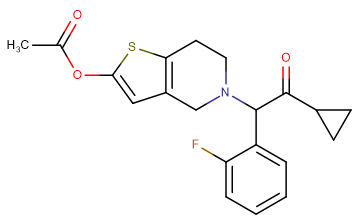
Prasugrel
CAS No. 150322-43-3
Prasugrel( CS 747 | LY640315 )
Catalog No. M12092 CAS No. 150322-43-3
Prasugrel, a thienopyridine derivative, is a platelet activation and aggregation inhibitor structurally and pharmacologically related to clopidogrel and ticlopidine.
Purity : >98% (HPLC)
 COA
COA
 Datasheet
Datasheet
 HNMR
HNMR
 HPLC
HPLC
 MSDS
MSDS
 Handing Instructions
Handing Instructions
| Size | Price / USD | Stock | Quantity |
| 25MG | 32 | In Stock |


|
| 50MG | 46 | In Stock |


|
| 100MG | 59 | In Stock |


|
| 200MG | 104 | In Stock |


|
| 500MG | 178 | In Stock |


|
| 1G | Get Quote | In Stock |


|
Biological Information
-
Product NamePrasugrel
-
NoteResearch use only, not for human use.
-
Brief DescriptionPrasugrel, a thienopyridine derivative, is a platelet activation and aggregation inhibitor structurally and pharmacologically related to clopidogrel and ticlopidine.
-
DescriptionPrasugrel, a thienopyridine derivative, is a platelet activation and aggregation inhibitor structurally and pharmacologically related to clopidogrel and ticlopidine. Similar to clopidogrel, prasugrel is a prodrug that requires enzymatic transformation in the liver to its active metabolite, R-138727. R-138727 irreversibly binds to P2Y12 type ADP receptors on platelets thus preventing activation of the GPIIb/IIIa receptor complex. As a result, inhibition of ADP-mediated platelet activation and aggregation occurs. Prasugrel was developed by Daiichi Sankyo Co. and is currently marketed in the United States and Canada in cooperation with Eli Lilly and Company for acute coronary syndromes planned for percutaneous coronary intervention (PCI). FDA approved in 2009. (In Vivo):In rat platelets, Prasugrel active metabolite inhibits in vitro platelet aggregation induced by adenosine ADP (10μM) with an IC50 value of 1.8 μM.Prasugrel acts faster and is significantly more potent than Clopidogrel in vivo. Prasugrel is an inactive prodrug that requires metabolic processing in vivo to generate the active antiplatelet metabolite. Prasugrel is rapidly absorbed from the gut. After oral administration of standard-loading doses of 60 mg, maximum plasma levels of the active metabolite are achieved within 1 h, effective, maximum inhibition of platelet aggregation at 1-2 h.
-
In Vitro——
-
In Vivo——
-
SynonymsCS 747 | LY640315
-
PathwayNeuroscience
-
TargetP2 Receptor
-
RecptorP2Y| P2Y12
-
Research AreaCardiovascular Disease
-
Indication——
Chemical Information
-
CAS Number150322-43-3
-
Formula Weight373.44
-
Molecular FormulaC20H20FNO3S
-
Purity>98% (HPLC)
-
SolubilityEthanol: 7 mg/mL (18.74 mM); DMSO: 30 mg/mL (80.33 mM)
-
SMILESCC(OC(S1)=CC2=C1CCN(C(C3=CC=CC=C3F)C(C4CC4)=O)C2)=O
-
Chemical Name5-(2-cyclopropyl-1-(2-fluorophenyl)-2-oxoethyl)-4,5,6,7-tetrahydrothieno[3,2-c]pyridin-2-yl acetate
Shipping & Storage Information
-
Storage(-20℃)
-
ShippingWith Ice Pack
-
Stability≥ 2 years
Reference
1.Dovlatova NL, et al. J Thromb Haemost. 2008 Jul;6(7):1153-9.
molnova catalog



related products
-
UDP disodium salt
UDP is a specific agonist of the P2Y6 receptors (EC50 = 13 nM for human P2Y6) stimulating the production of inflammatory mediators phagocytosis and vasoconstriction. UDP also acts as an antagonist of P2Y14.
-
HSP990
NVP-HSP990 (HSP990) is an effective and specific HSP90α/β inhibitor (IC50: 0.6 /0.8 nM).
-
GW791343 (HCl)
GW791343 is a P2X7 allosteric modulator.?



 Cart
Cart
 sales@molnova.com
sales@molnova.com


